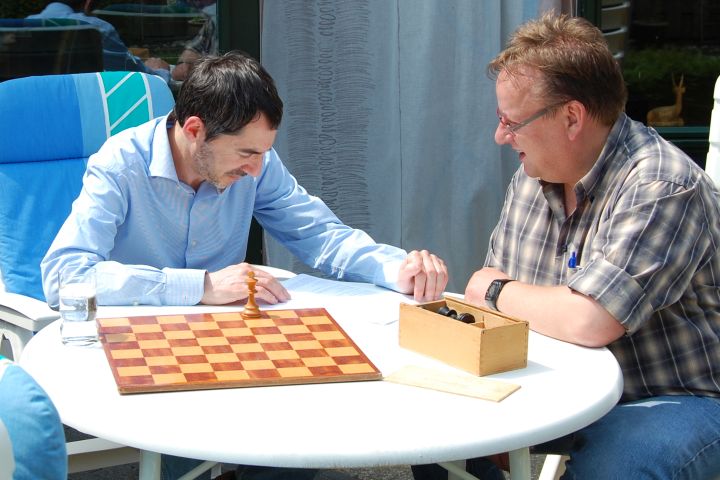In the first two parts of this series we described the Babson task – Black promotes to one of the four possible pieces and White must promote to the same piece in all four cases to win –, its implementation in chess problems, and the difficulty of creating a perfect Babson in a chess study. Here are the first two parts:
Today we proceed to a remarkable solution provided by Gady Costeff. Born in Beer Sheva, Israel 1961, Gady moved to the US where he lives since. He obtained the title of IM for chess composition (2008). He has published a relatively small number (around 100) of endgame compositions, but those are of very high level.
In the last article we presented two 75% Babson studies – they lacked the rook promotion – by Jan Rusinek and Gady Costeff, composed in 1980 and 1981.
But in 1998/99 Gady found a solution: a Babson study with working rook promotions.
1...Bc4+ 2.Kd4 Rd7+ 3.Kc5 Sa4+ 4.Kxc4 Se3+ 5.Kb4 Rxb7+ 6.Kxa4. It is really excellent that Gady managed to find a correct introduction where the wK plays from d3 all the way to its confined position at a4. Now the story develops further: 6...Sd1 7.Rxd1, and now:
- 7...exd1Q 8.e8Q! Qd4+ 9.c4! (9.cxd4? Rb4+ 10.axb4 stalemate) wins.
- 7...exd1R 8.e8R! (8.e8Q Rd4+ 9.c4 Rb4+ 10.axb4 stalemate!)
- 7...exd1S (threatens mate) 8.e8S+! Kf7 9.Sd6+ wins.
The full endgame study Babson accomplished!
As mentioned in the first part of this article, a thematic tourney was announced requiring an AUW study, without result. In 2004, the German editors Gerd Wilhelm Hörning and Gerhard Josten of an endgame study column in Rochade Europa, somewhat naively announced a thematic tourney requiring a full Babson task study. The prize fund was 500 EUR. Not a single study was entered.
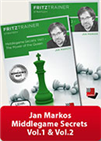 Let us learn together how to find the best spot for the queen in the early middle�game, how to navigate this piece around the board, how to time the queen attack, how to decide whether to exchange it or not, and much more!
Let us learn together how to find the best spot for the queen in the early middle�game, how to navigate this piece around the board, how to time the queen attack, how to decide whether to exchange it or not, and much more!For the outside world there apparently were not many activities around the full Babson task. The late Jan van Reek wrote en passant in a book that when he was judge for the Alexander Rueb Foundation Tourney (1984-1990), he received a full Babson task. But the study was unsound and withdrawn. In my booklet Pawn Promotion I speculated that Costeff or Rusinek must have been its composer. Now that we know that Jan Rusinek never tried to compose a full Babson study, the obvious conclusion was that Gady Costeff was probably the first to submit a full Babson study to a tourney. Of course, it could not be excluded that someone else did.
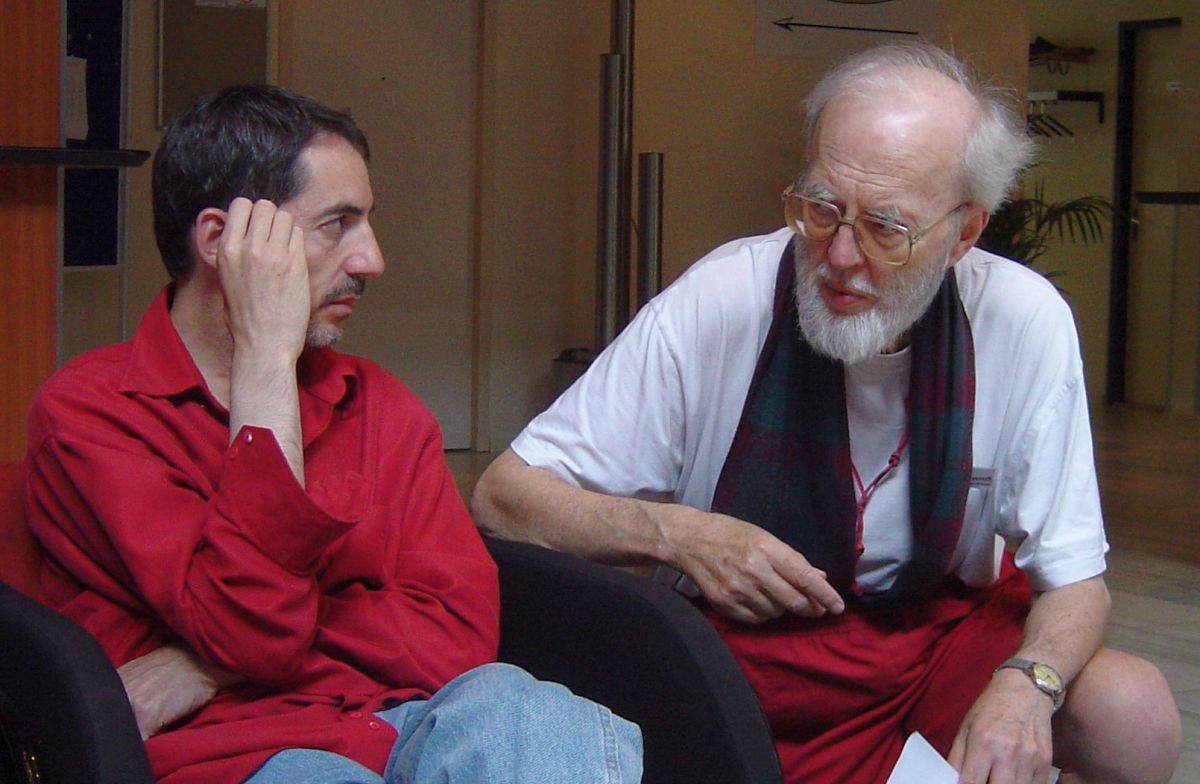
Gady Costeff with English composer and author John Roycroft in Wageningen 2006: John made significant contributions to the world of chess studies. He is now a hale 95 years old.
We had to wait another 20 years. In 2011 Gady sent me a scheme for soundness testing, that had the four reciprocal promotions, but required Black to promote on the first move.
Then, in 2012, when I was tourney director of an endgame study tourney, Gady Costeff submitted a full Babson task study with the unusual stipulation “White to move and not lose”, which looked analytically sound to me. The solution was a single move (indeed not losing, but winning). But the white alternatives were four different promotions, which were refuted by corresponding promotions by Black. The judge, whom I had sent the submitted studies in anonymized form, after long consideration and even asking for a second opinion, decided not to include the study in his award.
And now, again 12 years later, Gady Costeff sent me the following study:
A) 1...d1Q 2.fxe8Q! Qxd4+ 3.Sc4 Sc5+ 4.Sxc5 Rb4+ 5.axb4 wins.
B) 1...d1R 2.fex8R! (2.fxe8Q? Rxd4+ - or first 2...Sc5+ - 3.Sc4 Sc5+ 4.Sxc5 Rb4+ 5.axb4 stalemate; 2.fxe8B? Rxc1 and White cannot win, e.g. 3.Bxc1 Sxe5 4.Sc5 Rb5 5.dxe5+ Kxe5 6.Bxb5 axb5+ 7.Kxb5 Kxd5 wins. If 2.fxe8S+? Ke7 3.Sxg6+ Kxe8 and Black wins) 2...Rxd4+ 3.Sc4 wins.
C) 1...d1B 2.fxe8B! (2.fxe8Q/R? Sc5+ 3.Sxc5 Rb4+ 4.axb4 stalemate; 2.fxe8S+? Ke7 3.Sxg6+ hxg6 stalemate) wins.
D) 1...d1S (threatening mate) 2.fxe8S+! wins, e.g. Ke7 3.Sxg6+ hxg6 4.Rxc2 wins.
However, there is a “but”. Gady wrote me that the initial position unfortunately is not legal – i.e. it cannot be reached in a game. Here's the reason:
White has 12 pieces in the initial position. The missing pieces are queen, rook, bishop and two pawns. One of the missing pawns accounts for the third white knight. The promotion must have taken place at c8, d8, e8, or f8. Black must have captured the four missing pieces; two by his doubled pawns. And the c2, d2, and e2 pawns must in total have captured two times to reach those squares. So far everything fits, but I needed the help of GM Karsten Müller to see that in due course also White’s h-pawn must have been captured by a black pawn. And that is not possible.
Normally I do not reproduce e-mails in articles, but I think I must make an exception for this historical milestone.
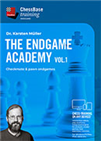 From Mating with a queen; a rook; two bishops; a knight and a bishop; to the basics of pawn endgames – here you will gain the necessary know-how to turn your endgame advantages into victories!
From Mating with a queen; a rook; two bishops; a knight and a bishop; to the basics of pawn endgames – here you will gain the necessary know-how to turn your endgame advantages into victories!
Gady Costeff (Saturday 7 September): Dear Harold, Attached is an original study - though just short of legality. I think it is correct but my computer does not have 7-piece databases. If you can verify this I would be grateful”.
Harold van der Heijden (Monday 9 September): Dear Gady, I started reading your e-mail (dating back to Saturday….) only about half an hour ago. It is absolutely sensational!
However, the fact that the position is not legal is a major drawback. Therefore, my question is: are you sure that you want to publish it now? I seem to remember this matrix from a version you composed about 10 years ago (with the extra stipulation that Black had to promote on the first move), so I suppose that you have spent a lot of time to come to an analytically sound version (a huge step for mankind!), and are becoming fed up with it.
But it feels similarly to the (hypothetical) situation that the study would be sound if Black does not play 1…Ke7. Would you then publish it? My obvious advice would be to try harder (…) and make a legal version.
Gady Costeff (Monday 9 September): Thank you Harold for your thoughtfulness. Yes - I do want to publish it in October in EG. I composed this in 2011 and tried for a decade to make it legal. The pleasure of 45 years of research and learning is far more dear to me than any publication honors. I do not care at all if the study is left out of the award for being illegal. I do think it is interesting and readers would be interested in how a Babson may look. Thank you for your help - we share a longtime love of underpromotions”.
Such things (“try harder”) you can only say to a true chess friend...
After the successful Israeli Ring ty study, all subsequent versions (I have seen) have a similar matrix.
I must admit that I naively attempted to get rid of the illegality problem by making a small change in the initial position. I heard that other people tried the same thing (e.g. proposing to remove bPa7 – which leads to duals that require more than superficial analysis to find). You can be sure that Gady has tried every possible small change during the past decades. We can be certain that trying to find a correct setting needs a fundamental change of the position – for instance transferring the wK to the king side. The promotion scheme seems to require the bS to threaten a mate, but that could also happen on f2. This is not a serious attempt, but illustrates the fact that out-of-the-box thinking is necessary.
Another disadvantage of the present version is the extra white knight and the fact that it starts with BTM. Those are all allowed, but sub-optimal. I see a strong parallel with the Drumare case, trying to compose a chess problem with the Babson task, also using promoted pieces.
Finally, Costeff’s study is exceedingly complicated, and I have spent many hours analysing it, in particular the lines 1...Sd6 and 1...Ke7. In the end I came to the conclusion that the study is sound – which means that I was unable to spot a cook. A week ago (Oktober 20), GM Karsten Müller e-mailed me to state that he came to the same conclusion. Of course, it cannot be excluded that someone finds a refutation.
But the whole point to publish it now that it might inspire composers to try and give it a go. Will you become the new Yarosh?
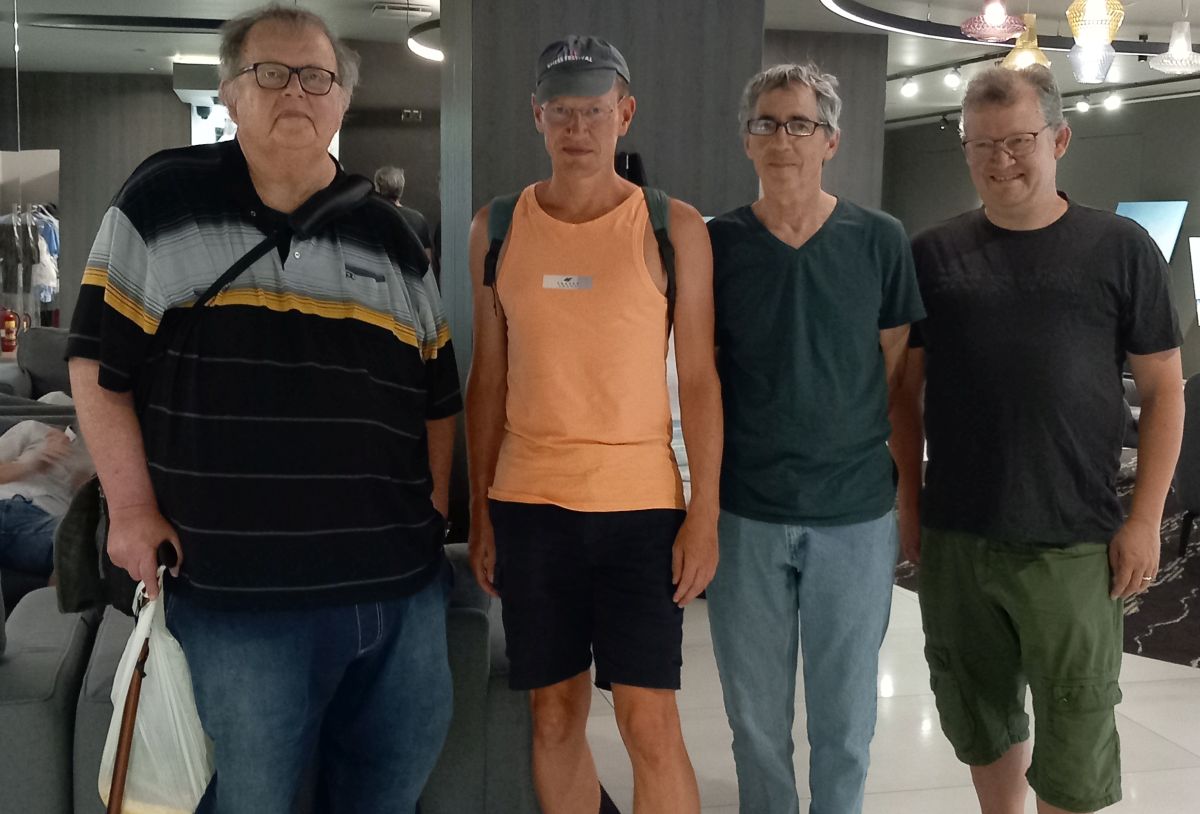
All together: leading chess endgame study experts Yochanan Afek, Martin Minski, Gady Costeff and Steffen Slumstrup Nielsen | picture by Luc Palmans.
Here are the two studies for you to replay and analyse:
Acknowledgements
Thank you, Jan Rusinek and Gady Costeff for providing details on their Babson attempts in the past. Also the discussions with Karsten Müller and Anirudh Daga were quite helpful. Surely, Frederic Friedel was the right person to convert my text into an attractive article series on the ChessBase site.
